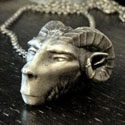|
So the design has no preload between the components, it just tries to do a zero clearance fit between the surfaces. Uh... This is not a good idea. Expect chatter as it bounces up and down, if you put any significant load on it. You could try a thread locking bolt. Works on the same principle as a nyloc nut. Not sure it'll give you enough locking force, but it's a pretty easy way. http://www.mcmaster.com/#socket-head-cap-screws/=tc0fxp You could also just c-bore out the base to a larger size. No problems with using a larger bolt, although you might have to use a low profile bolt.
|
|
|
|

|
| # ? May 24, 2024 11:31 |
|
ReelBigLizard posted:
This is what I will be doing. I thought of it at work today, since the hole is already tapped right through the round part. This fits on my Sherline lathe, so the whole tool is much smaller than it was originally designed. For an idea of scale, the cutting bit I have mounted is 1/4"
|
|
|
|
Talk to me about regulators. I'm building a gas forge, it'll burn propane. The burner is going to be this guy : 3/4" T-rex It looks like it need between 4 and 10 psi. I know I can't get just a cheapo BBQ grill regulator, but there's a big range. Amazon has a nice $40 one, and Harbor Freight has regulators as low as $10. Airgas says a "Decent" regulator will set me back $150. I also see simple brass inline regulators that cost $4, and they just have a thumbscrew with no gauge. What's the difference? I don't want to go cheap and blow myself to pieces, but I don't want to spend more money than I have to.
|
|
|
|
You need a regulator rated for use with your flammable gas, not an "air" regulator.
|
|
|
|
http://www.amazon.com/Goss-EP-70G-P...opane+regulator that is what I use. As leperflesh said, you need to get something designed for flammable gas.
|
|
|
|
Thank you. One last question, is there any sort of material you add to joints? Similar to the teflon tape you put on water-based plumbing? Should I use a joint material at all, and if so, what should I get?
|
|
|
|
Are you talking about your gas line couplings? Yes, there is a yellow tape that you use, which is specifically rated for gas. Note that some gas line couplings are designed (and labeled) to be tightened exactly once, with a specific number of wraps of the yellow tape. Once you take them apart again you're supposed to replace them. If you're not sure, look for manufacturing info on your couplings. Running gas line is much more serious business than air hose. A small leak in a confined space overnight can equal your fiery death. Please be careful and don't try to cheap out on your gas line.
|
|
|
|
Metal goon bros help me out. I'm wanting a home coffee roaster and hope there's a metalworker In the thread that does small jobs. I can post something in themart but thought I'd try here first. I'm familiar with the other parts I need but run into a bit of an issue with the 304 solid stainless steel drum. I do see things like it for sale on ebay, and parts to other roasters, but it's ebay and not exactly what I need.
|
|
|
|
MasterControl posted:Metal goon bros help me out. I'm wanting a home coffee roaster and hope there's a metalworker In the thread that does small jobs. I can post something in themart but thought I'd try here first. What exactly do you need? Dimensions etc.
|
|
|
|
SmokeyXIII posted:What exactly do you need? Dimensions etc. SmokeyXIII posted:What exactly do you need? Dimensions etc. This is from an ebay post that kind of fits my needs.) Drum dimensions are: 8" in length by 7" in diameter. Drum has 8" diameter heavy duty 20 gauge type 304 Stainless Steel end cap plates. Drum cage is made from thick 20 gauge perforated (1/8" inch diameter perforations) aluminum sheet and has 3 interior aluminum fins that run the entire 8" in drum length and rise 3/4" inch each into drum interior. All riveted for solid construction. I use a huky 500. Drum pictures can be seen about 15 down here. I pretty much want this but double in size. http://www.home-barista.com/home-roasting/exploring-huky-500-coffee-roaster-part-i-t20245.html
|
|
|
|
MasterControl posted:This is from an ebay post that kind of fits my needs.) I stand in awe at that roaster. That is some serious craftsmanship for a hobby that already seems to border on insanity. How much does that thing cost? It has to be like over a grand.
|
|
|
|
Hu Fa Ted posted:I stand in awe at that roaster. That is some serious craftsmanship for a hobby that already seems to border on insanity. Pretty close, 1300! There are some extra parts too like fans and duct. Shipping and stuff came to about 1600.
|
|
|
|
hey guys this rolled across my pinterest and I think its rad http://applescottysscrapbook.blogspot.com/2008/02/sensitive-drill-press.html
|
|
|
|
Leperflesh posted:Are you talking about your gas line couplings? Yes, there is a yellow tape that you use, which is specifically rated for gas. Seconding this. Use yellow PTFE tape designed for LP gas, use a hose rated for LP gas, and use a regulator rated for LP gas. They make quick connect fittings similar to the ones you use for your air compressor that are rated for flammable gasses, do not use regular air ones. You might be able to find them at a place that sells RV parts, as I've seen them used on board those.
|
|
|
|
So what precautions should be taking when setting up welding / blacksmithing gear in a rickety and fairly dry old wooden garage? Besides a large fire extinguisher?
|
|
|
|
Rime posted:So what precautions should be taking when setting up welding / blacksmithing gear in a rickety and fairly dry old wooden garage? Besides a large fire extinguisher? Some thoughts off the top of my head. Keep an air pressurized water based fire extinguisher handy for all but the most severe problems. The one on amazon is junk, because it doesn't have a schrader valve on it so you can't re-pressurize it with your air compressor. But they seem to turn up for cheap at auctions or make friends with a fire fighter. They're not allowed by the fire codes any more so they usually just toss them in the garbage. Consider welding blankets and keep the floor free of sawdust / oily rags etc. Actually, I'd keep all my stuff portable and pull it outside to do blacksmith work. Maybe build an overhang and brick up an area. Chemical fire extinguishers make a loving mess and you will spend weeks cleaning it up. Don't hesitate to use it, but make sure you need it I guess.
|
|
|
|
Pfft, just have good insurance and don't be an idiot. Yeah, definitely keep a fire extinguisher around. Don't keep anything in the barn that you're worried about burning. It's going to get covered in soot, grinder dust, scale dust and grime anyway. If you DO have a fire, it'll be ok. All your blacksmithing tools will survive just fine. Well, the power tools won't, but that's why you should have insurance.
|
|
|
|
Don't put galvanized metal in your forge ever ever ever. EVER
|
|
|
|
Radius turning attachment update: I made a small 1/4-20 screw and used it to set the depth of the screw with the bearing surface. It holds it nicely and doesn't back out any longer.  I turned a concave radius yesterday to test it and it came out nicely. I will try to make a convex radius next week.
|
|
|
|
Has anyone worked much with small springs? I'm working on a project right now that I need a pair of really small (almost wrist watch small) flat coil springs similar to this: http://www.wermkespring.com/spiral-spring.html My hope is that I could just get a band of thin steel flat wire and heat temper it into a spring, but I know very little about working with steel and I might have no idea what I'm talking about! Any help or even suppliers that could have something like this would be much appreciated!
|
|
|
|
I don't think normal steel wire stock will cut it, unless it's very light duty. Have you tried looking into clock/watch repair suppliers to see if there is a stock item that matches your needs?
|
|
|
|
Besides that, handmade springs won't have a reliable spring constant. You can build a winding jig using a lathe that has auto feed though. Just make sure you can hold tension as you wind to get the correct diameter and the coil height can be handled with the feed.
|
|
|
|
Claes Oldenburger posted:Has anyone worked much with small springs? I'm working on a project right now that I need a pair of really small (almost wrist watch small) flat coil springs similar to this: http://www.wermkespring.com/spiral-spring.html If you can use round wire instead of flat ribbon, guitar strings will work well and are much cheaper & more available not sure how you'd wind one of those though
|
|
|
|
A gunsmith I know uses piano wire to make springs. Not sure what the lightest gauge you can get though.
|
|
|
|
rotor posted:not sure how you'd wind one of those though or from sproinging all over the place, now that I think about it please disregard my suggestion.
|
|
|
|
rotor posted:or from sproinging all over the place, now that I think about it You could wind it on a spindle between two large penny washers or bushings set at the thickness of the wire, I think. I still think the easiest option is going to be to find a stock clock/watch spring and trim/bend to fit.
|
|
|
|
ReelBigLizard posted:You could wind it on a spindle between two large penny washers or bushings set at the thickness of the wire, I think. Yeah, seeing as how small it is it might be the best way to just go stock and work that in. Awesome brainstorming though everyone, if that doesn't work, I'll be back!
|
|
|
|
I made a custom spring for someone on my lathe. It was made from piano wire. Didn't need to heat treat it.
|
|
|
|
makin some nerd poo poo  (its gonna be a gorget- i'll cut it out and punch holes at the corners and weave some nice heavy brass chain for it)
|
|
|
|
Ambrose Burnside posted:makin some nerd poo poo BURN THE HERETIC Looking loving sweet, man. Your metalwork stuff just gets better and better.
|
|
|
|
My penance for the chasing/repousse OP post still being unfinished is keepin at 'er and posting pics as I go~
|
|
|
|
I am looking forward to it. I made some repousee stakes that I have used to make some irises. (They are still in progress.) I would really love to learn some more about it. Ambrose, I was wanting to learn more about damascene and feeling you might know something about it. Actually in my mind damascene, silver/gold inlay and koftgari are all they same thing. I really don't know if that is true. Anyway, I want to carve and inlay copper into my steel. I can also melt the wire and hammer it in, but it didn't turn out too well in my test piece. If anyone knows how to do this, or can point me in the right direction I would really appreciate it. There is class coming up that teaches it. http://forgedaxes.com/?wpsc-product=fine-silver-designs-on-steel-aka-koftgari However, it is $280, and is mostly a bladesmithing class. ArtistCeleste fucked around with this message at 02:47 on Sep 8, 2014 |
|
|
|
I don't know much, or rather, I don't know anything you can't find in the usual first-recommendation bladesmithing et al books. which i'm, ah, spacing on atm The difference between damascene/mokume-gane and inlays is that the former is purpose-made as a raw material and the latter is a decorative technique applied selectively to homogenous base stock or partially-finished goods. I can't comment on pattern-welding beyond hearing it's finicky and kind of a weird niche to get good in if you're anything but a bladesmith. I've braze-welded flattened pennies together with yellow brass wire and then flattened them further, but that doesn't really count, I don't think. I've done some limited inlay work but it's the rude n crude kind, flooding chased linework with solder and filing it flat afterwards, stuff like  Most 'real' inlays are done with gravers and wire; my engraving game is very weak so I've never given it a serious try. Inlay quality is judged by the uniformness and evenness of the finished inlay so melting metal into a groove or cutout is almost always going to look sloppy. I've done bimetal pewter 'inlay' rings but that's a cheat because the pewter is so soft that you can hammer the inlay wire down into the ring wherever, no channel-cutting required, without deforming the inlay too badly. The wire stays in place because I just melted the ends down into the body of the ring. 
|
|
|
|
Thanks for the response. I will look up engraving. It gives me another key word at least. Damascus and damascening, I guess are sometimes used interchangeably. Damascening is also a type of metal inlay. It looks more complex than wire inlay, but I can't find too much about the process. http://en.wikipedia.org/wiki/Damascening I am actually going to a workshop in a couple of weeks to make a pattern welded billet. I will update you guys on what I learned after. I am trying to figure out what to use it for. I have made enough knives to know that I don't care that much about making knives. But then again, I might make straight razor.
|
|
|
|
oh, whoops, i did think your talkin about Damascus was kind of out of place IIRC for metal the inlay grooves are cut and then undercut from either side, so the cut opens up as you go deeper and gives the inlay a place to expand into when set with a planisher. I think you can achieve a similar result with a deep acid etch, which would be better-suited to steel and much easier to execute well without much practice, but I'm not much of an etcher either. I bet Ganoksin has some inlay guides.
|
|
|
|
Almost done. Not going to futz with the sunken backing any more even though there are some things that are really bugging me, like the deep out-of-place dimpling along the top edge ('cause I screwed up and started outlining with a pointed punch instead of a flat-faced one, because I don't bother consulting my previous project notes, like an idiot) and the liner marks visible here n there along the edges of the aquila. Just need to sand down the edges a bit more evenly, hit the backing with some liver of sulfur and fine steel wool, punch holes in the corners for a chain, and weave the chain up.  ArtistCeleste- here's some handy stuff on inlay I found on ganoksin to help visualize what's up.  10.18 Inlay with engraved recesses a - raising a bead, side view b - First cut c - Second cut to inset wire e- Inserted wire hammered into place  10.19 Inlay with chiseled groove a - chisel cut, side view b - chisel cut c - chiseled groove d- tapping down the ridge e- hammered inlay completed  10.20 Inlay with punched grooves a - punch side view b - incised groove c - flat punches side view d- enlarging the channel e - hitting down the edge f - finished inlaid wire g - rounding off the inlaid wire for relief inlay
|
|
|
|
God drat I don't think I could do that without punching right through thin stock. How long does it take to learn the fine control needed to do that kind of work?
|
|
|
|
Inlay with punches really is just repousse lining with a flat running punch follow-up, which I could probably pull off if I was so inclined. Controlling a repousse punch really isn't that hard once you figure out what's going on and how to hold it and strike it so the punch doesn't run away from you, the punch largely moves itself a step with every hammerblow, but engraving is still a blank for me because you have to apply a bunch of manual force concentrated on the leading edge of the graver and it is incredibly easy for it to jump out of the metal and gouge the poo poo out of the workface or dive deep and make an unfixably-wide engraved line. e: if you mean 'repousse in general', the answer is: ductile metals, a forgiving supporting medium, and a preternatural sense for when standard cuprous work-hardening turns into Cracking Imminent Ambrose Burnside fucked around with this message at 16:40 on Sep 11, 2014 |
|
|
|
Ambrose Burnside posted:engraving is still a blank for me because you have to apply a bunch of manual force concentrated on the leading edge of the graver and it is incredibly easy for it to jump out of the metal and gouge the poo poo out of the workface or dive deep and make an unfixably-wide engraved line. This is exactly how I feel every time I try to engrave something  Apparently air engravers make the chance of this happening wayyyy less, but like any great tool they are expensive. Apparently air engravers make the chance of this happening wayyyy less, but like any great tool they are expensive.
|
|
|
|

|
| # ? May 24, 2024 11:31 |
|
Wow, thanks Ambrose! I have sooo many projects going on, but I will be sure to document and post when I figure out how to do inlay correctly.
|
|
|




















